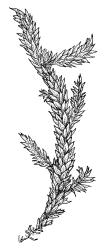The following generic description includes elements from Hedenäs (2003) and Ochyra et al. (2008).
Plants medium-sized to robust, variably coloured, forming interwoven mats in wet places and often submerged or emergent. Stems sparsely to densely and radially branched, either lax or ascendant and self-supporting, lacking a hyaloderm in N.Z. species, with a central strand; rhizoids sparse, scattered on stems, sometimes also arising from scattered rhizoid initial cells near leaf apices, smooth. Stem leaves falcate or straight and loosely erect, lanceolate-acuminate, oblong-ovate or broadly ovate and short-apiculate and reflexed at apex in N.Z. species, plane at margins, entire or denticulate above, smooth or striolate when dry, not or weakly decurrent in N.Z. species; mid laminal cells unistratose, linear or linear-rhomboid, firm-walled, porose or not, sometimes with differentiated rhizoid initials which are broader and less chlorophyllose than adjacent cells; basal laminal cells shorter and broader, porose; alar group medium-sized or large, gradually differentiated from adjacent laminal cells, the cells inflated and thin-walled, hyaline or pigmented. Costa well-defined, single and unbranched, ½ to nearly the full leaf length in N.Z. species. Branch leaves smaller and sometimes narrower, otherwise similar. Paraphyllia absent.
Autoicous or dioicous. Perichaetia scattered on stems, the leaves tapered to an acuminate apex, costate, not plicate. Perigonia scattered on stems or below the perichaetia, often inconspicuous, the bracts ecostate in N.Z. species. Setae long, flexuose, red-brown; capsules cylindric, inclined to horizontal, curved with a rather short neck; exothecial cells firm-walled; stomata numerous and elliptic; annulus not differentiated; operculum conic. Peristome hypnoid, as per family; exostome teeth well-developed, pale yellow-brown, on the outer surface with a zig-zag median line, transversely striolate below, shouldered and strongly bordered; endostome from a high basal membrane, the segments keeled and not or weakly perforate, with nodose cilia in groups of 2–4. Calyptra cucullate, naked. Spores spherical, finely papillose.
Warnstorfia is a genus of about nine or ten species (Hedenäs 2003). The genus is best developed in temperate regions, particularly in the northern hemisphere, but also occurs at high elevations in the tropics. Two species are accepted as belonging to the N.Z. flora. Warnstorfia fluitans was treated in Drepanocladus and W. sarmentosa in Calliergon by Sainsbury (1955).
| 1 | Stem leaves narrowly lanceolate, narrowed gradually to an acuminate and non-reflexed apex, usually ± falcate-secund, at least at stem tips, not striolate when dry; autoicous | W. fluitans |
| 1' | Stem leaves oblong-ovate or broadly ovate, obtuse or short-apiculate and usually reflexed at apex, not falcate-secund at stem tips, striolate when dry; dioicous or sexuality indeterminate | 2 |
| 2 | Plants usually wine-coloured to nearly black; upper laminal cells porose; stem leaves apiculate and reflexed at apex; dioicous; restricted to elevations of >975 m | W. sarmentosa |
| 2' | Plants straw-coloured; upper laminal cells not or very weakly porose; stem leaves neither apiculate nor reflexed at apex; sexuality indeterminate; occurring at low elevations | W. fluitans (submerged forms, including "calliergidium" growth form) |
According to Hedenäs (2003) axillary hairs in Warnstorfia have 1–2 short brown basal cells and 1–7 elongate and hyaline upper cells.
| Category | Number |
|---|---|
| Indigenous (Non-endemic) | 2 |
| Total | 2 |
Warnstorfia exannulata: I have seen no wholly convincing material of W. exannulata (Schimp.) Loeske from N.Z., although a specimen from Percy Saddle in Fiordland (J.K. Bartlett s.n., AK 198249) is suggestive in many ways of it. A full treatment of W. exannulata is not given here, pending the study of more convincing material. Compared to representative N.Z. material of W. fluitans, the Percy Saddle material has a larger, more auriculate alar group (extending ± to the costal base) with more inflated and thinner-walled cells. The plants have a clear red pigmentation and weakly toothed lower leaf margins; they are sparsely and irregularly branched and completely lack a hyaloderm. Cobb Valley (Nelson L.D.) specimens cited by Bartlett (1984) as Drepanocladus exannulatus are referable to W. fluitans. Material from the Garvie Range, Southland L.D. (P.N. Johnson 24, CHR 414127) which was named as this species by Hedenäs in 1996 is, in my opinion, a mixture of Scorpidium cossonii and Straminergon stramineum. I have not seen material from the Great Moss Swamp, Lammermoor Range, Otago L.D. (W.B. Schofield 48697, S) which Hedenäs (pers. comm. 21 Mar. 2006) considered W. exannulata.
Warnstorfia laculosa (Müll.Hal.) Ochyra & Matteri has been cited by Ochyra & Matteri (1997) as an earlier name for Calliergidium austro-stramineum (Müll.Hal.) E.B.Bartram. Both these names are discussed under "excluded taxa" above.




